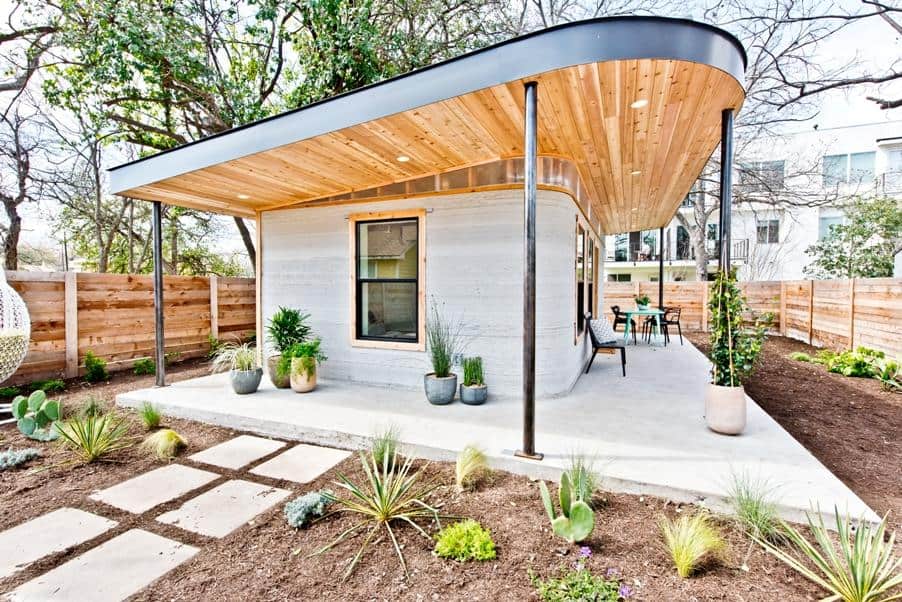Wealthtender is a trusted, independent financial directory and educational resource governed by our strict Editorial Policy, Integrity Standards, and Terms of Use. While we receive compensation from featured professionals (a natural conflict of interest), we always operate with integrity and transparency to earn your trust. Wealthtender is not a client of these providers. ➡️ Find a Local Advisor | 🎯 Find a Specialist Advisor

Austin-based startup, ICON, built the first permitted 3D printed home in America. Photo courtesy ICON.
In the world of alternative housing, probably nothing seems more experimental than 3D printing an entire house. But a handful of innovative startups seem up for the challenge.
In just the past few years, 3D printers have built everything from an office building in Dubai, a troops barracks for the U.S. Marine Corps, a pedestrian bridge in Spain, and several prototype homes around the world.
Even NASA sees the potential of 3D printed construction. They’re holding a design competition called the 3D-Printed Habitat Challenge. They’ve invited architectural and design firms to submit plans for building a sustainable habitat on Mars using 3D printers. This isn’t some small competition, either. NASA is offering over $3 million in prize money in various categories to the winners.
How does 3D printed construction work?
3D construction printers use huge robotic arms or cranes with a nozzle attached. The nozzle dispenses concrete in a pre-programmed pattern. The printer constructs the foundation and walls of the structure layer by layer from the ground up.
This short video shows an Apis Cor 3D concrete printer constructing a house. Apis Cor says the total cost for the house was $10,134 and took 24 hours to build. The company claims the house can withstand rough weather conditions and will last 175 years. The finished house has four rooms, electrical and plumbing, and looks pretty amazing!
An opportunity for affordable housing
Many of the startups in the 3D construction industry see the potential for making a huge impact in the world of affordable housing. They want to bring lower cost housing to those parts of the world where there is a critical shortage.
While concrete is the material of choice for most companies, Italian company, WASP, is focusing their efforts on producing 3D printers that can construct eco-friendly, sustainable housing. They plan to bring this technology to developing countries where building materials are often expensive and in short supply.
WASP creates what they call a “3D printed earth house,” built using natural resources already on site. Their goal is to lessen the environmental impact of construction by using raw materials normally considered waste. For example, during one recent construction they used raw earth and rice waste (straw and husk) to 3D print a house.
This company says they’re building a whole village of 3D printed homes for $4,000 each
ICON is a construction tech company based out of Austin, Texas. In 2018, they built the first permitted 3D printed house in America. They’ve partnered with a housing nonprofit, New Story, to bring safe and affordable housing to impoverished areas of the world. For example, ICON worked with New Story to build homes for families living in Tabasco, Mexico, who, prior to this, had been living in extreme poverty and makeshift, unsafe shelter. Icon believes they can get the cost down to $4,000 per house with a build time of less than 24 hours.

Interior of ICON’s prototype house built using their Vulcan 3D concrete printer. Photo courtesy ICON.
An opportunity for investors
It appears investors are taking a serious look at 3D printed construction and they like what they see. ICON raised $9 million in seed money to help fund the development of their Vulcan concrete printer.
But this amount is just a drop in the bucket compared to what some companies and governments are willing to invest in the industry. A Saudi Arabian construction company signed a deal to lease 100 construction printers from the Chinese company, Winsun. The deal is said to be worth $1.5 billion. To keep pace with anticipated population growth, Saudi Arabia needs to build 3 million new homes over the next decade. The plan is to use 3D printing to meet a good portion of this need.
The United Arab Emirates (UAE) also plans on using 3D printing to meet its crushing demand for new buildings. The government says 25 percent of Dubai’s buildings will be 3D printed by 2030.
Some housing experts believe we’re at the beginning of a huge growth in investments targeted at alternative housing. The need for inexpensive, high quality, durable housing is growing as the population grows and as people move from rural areas to cities in the search for better jobs and a better standard of living. Some innovators envision a future in which anyone can build their own customized home using a 3D printer.
To discover more about this exciting housing trend, see my article, 3D Printed House: Your Guide to the Future of Affordable Housing.
Wealthtender is a trusted, independent financial directory and educational resource governed by our strict Editorial Policy, Integrity Standards, and Terms of Use. While we receive compensation from featured professionals (a natural conflict of interest), we always operate with integrity and transparency to earn your trust. Wealthtender is not a client of these providers. ➡️ Find a Local Advisor | 🎯 Find a Specialist Advisor

